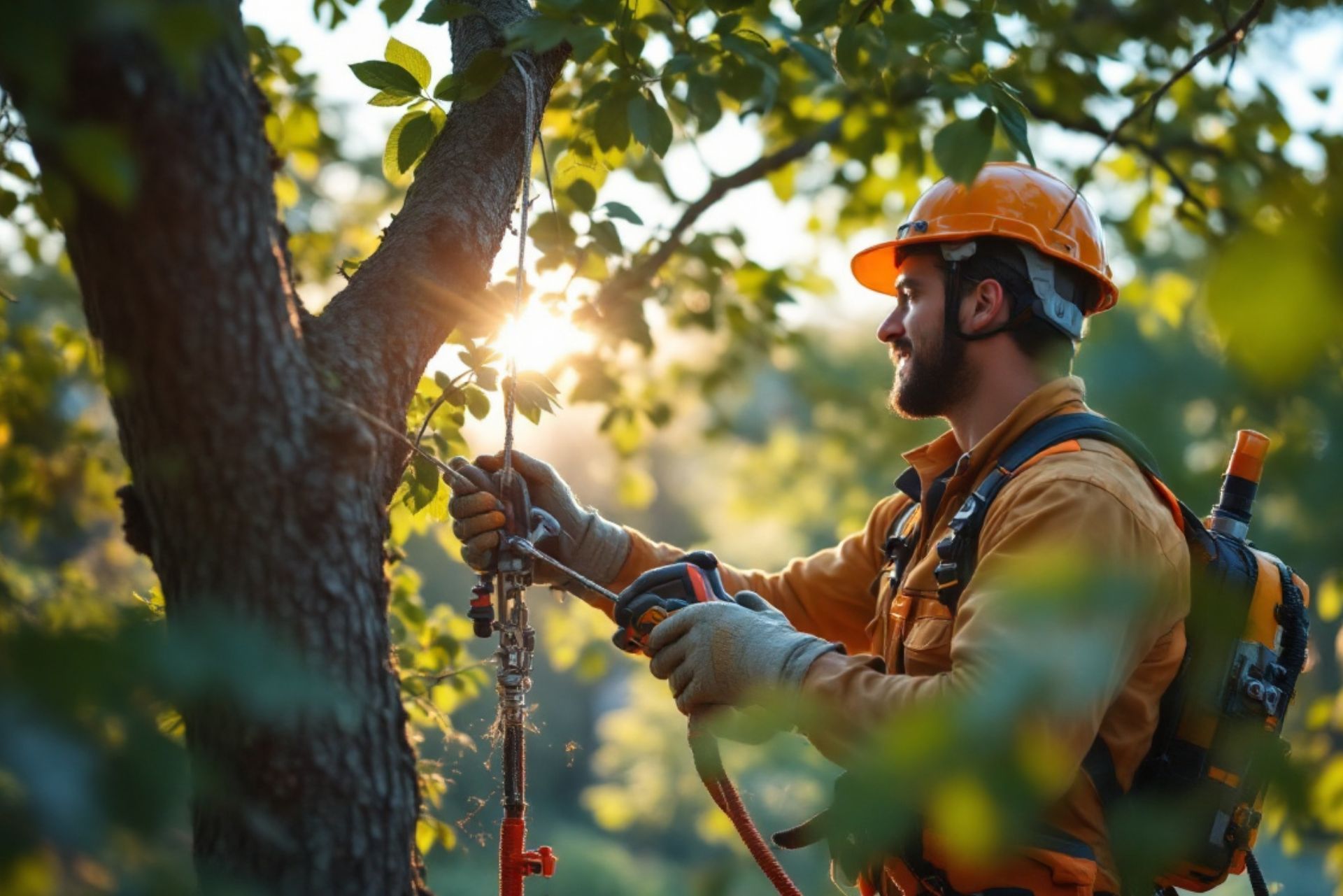Top 3 Recommended Policies
Index
Contact Us
Phone
Location
Running a tree trimming business in Indiana involves various risks, from injuries on the job site to damage caused to property. To safeguard your business, it is essential to understand the intricacies of tree trimmer insurance. This comprehensive guide will cover everything you need to know about getting the right insurance coverage in Indiana.
Understanding the Basics of Tree Trimmer Insurance
Tree trimmer insurance is a specialized type of coverage designed for businesses engaged in tree care and maintenance. This insurance protects against accidents, damages, and legal liabilities that may occur while performing tree trimming or removal services.
What is Tree Trimmer Insurance?
Tree trimmer insurance typically encompasses several types of coverage, including general liability, workers' compensation, and property insurance. General liability insurance covers third-party bodily injury or property damage, while workers' compensation protects your employees in case of work-related injuries.
Additionally, equipment and tools used in tree trimming may also be covered under a specific policy designed for this industry. It is vital for business owners to review their coverage options carefully to ensure adequate protection against the unique risks they face. For instance, policies can include coverage for specialized machinery like chippers and stump grinders, which are essential for efficient tree care operations. Understanding the nuances of these policies can help business owners tailor their insurance to meet specific operational needs.
Why is Tree Trimmer Insurance Important?
Tree trimming is inherently risky, and accidents can happen unexpectedly. Without proper insurance, a single incident could lead to significant financial losses, including medical expenses, legal fees, or equipment replacement costs. Insurance helps mitigate these financial risks, allowing businesses to operate with peace of mind.
Moreover, clients often prefer hiring insured professionals, as it serves as a testament to the business's reliability and commitment to safety. Having tree trimmer insurance not only protects your financial interests but also enhances your company's reputation in the marketplace. In addition to attracting more clients, being insured can also open doors to larger contracts, as many commercial properties and municipalities require proof of insurance before hiring tree care services. This requirement underscores the importance of maintaining comprehensive coverage to not only safeguard your business but also to position it favorably in a competitive industry.
The Scope of Tree Trimmer Insurance in Indiana
In Indiana, tree trimmer insurance varies by provider and specific coverage options. Understanding the scope of your policy ensures you can protect your business effectively against common risks in the industry.
Coverage Aspects of Tree Trimmer Insurance
Several coverage aspects are essential in a tree trimmer insurance policy. Typical coverages include:
- General Liability: Covers bodily injury and property damage claims from third parties.
- Workers' Compensation: Provides benefits to employees injured on the job.
- Commercial Auto: Covers vehicles used for business purposes.
- Equipment Coverage: Protects tools and machinery against theft or damage.
Each of these components plays a crucial role in ensuring that tree trimmers are protected against various operational risks. Evaluating these coverages according to the specific needs of your business will serve you best. For instance, general liability insurance is particularly vital as it can safeguard your business from lawsuits that may arise from accidents on job sites, such as a falling branch injuring a passerby. Additionally, workers' compensation is not only a legal requirement in many cases, but it also fosters a safer working environment by providing employees with the necessary support in case of work-related injuries.
Limitations and Exclusions
While tree trimmer insurance provides significant coverage, it's essential to be aware of its limitations and exclusions. For instance, most policies may not cover deliberate acts, wear and tear, or damage caused by natural disasters. Additionally, if certain activities are deemed high-risk, insurers may impose restrictions.
Reviewing the fine print of your insurance policy will help clarify what is not covered, allowing you to take proper precautions and, if necessary, seek additional riders to cover potential gaps. It’s also worth noting that some providers may offer specialized endorsements that can enhance your policy, such as coverage for aerial lifts or tree removal services that involve more hazardous conditions. Understanding these nuances can help you tailor your insurance to fit the unique challenges faced by your business, ensuring comprehensive protection against unexpected events.

The Cost of Tree Trimmer Insurance in Indiana
The cost of tree trimmer insurance in Indiana can vary widely based on several factors specific to your business operations. Understanding these elements can empower you to make informed decisions regarding your insurance policy.
Factors Influencing the Insurance Premium
Several key factors influence the cost of tree trimmer insurance, such as:
- Business Size: Larger companies typically pay more for insurance due to increased exposure.
- Experience and Claims History: A clean history can lead to lower premiums, while prior claims may increase costs.
- The Scope of Operations: The range of services offered and the scale of projects impacts insurance rates.
- Type of Equipment: The value and types of equipment used can also affect your premium.
By understanding these factors, tree trimming business owners can better anticipate their insurance expenses and budget accordingly. Additionally, the geographical location within Indiana can also play a role in determining rates. For instance, businesses operating in urban areas may face different risks compared to those in rural settings, potentially leading to variations in premiums. Moreover, the seasonal nature of tree trimming services can also influence costs, as demand fluctuates throughout the year, affecting how insurers assess risk.
Tips to Lower Your Insurance Costs
Lowering your insurance costs is a goal for many business owners. Here are some practical tips to consider:
- Shop Around: Compare quotes from multiple insurance providers to find the best rates.
- Bundle Policies: Consider bundling different types of insurance to secure discounts.
- Improve Safety Protocols: Implementing robust safety practices may result in lower premiums.
- Increase Deductibles: While this means higher out-of-pocket costs in the event of a claim, increasing your deductibles can lower your premiums.
Employing these strategies can reduce costs while still maintaining necessary coverage. Additionally, investing in training programs for your employees can further enhance safety and efficiency, which not only helps in reducing the likelihood of accidents but may also be viewed favorably by insurers. Furthermore, staying updated on industry best practices and regulatory changes can ensure your business remains compliant and potentially eligible for additional discounts, as insurers often reward proactive measures that mitigate risk.
Legal Requirements for Tree Trimmer Insurance in Indiana
Understanding the legal landscape surrounding tree trimmer insurance is crucial for business owners. Indiana has specific regulations in place governing insurance requirements for such businesses.
State Regulations for Tree Trimming Businesses
In Indiana, businesses in the tree trimming industry are typically required to maintain a certain level of insurance coverage, especially for workers' compensation. This is crucial for protecting employees and ensuring compliance with state laws. Failure to adhere to these regulations can result in penalties or legal action.
It's advisable to stay updated on any changes to state regulations to avoid potential complications in your business operations. Additionally, tree trimming businesses should consider obtaining general liability insurance, which can provide coverage against third-party claims for bodily injury or property damage. This type of insurance is essential, as accidents can happen unexpectedly, and having the right coverage can safeguard your business's financial health.
Consequences of Not Having Adequate Insurance
The lack of adequate insurance can lead to devastating consequences for tree trimming businesses. Without coverage, owners become personally liable for any accidents, injuries, or damages. This situation can result in significant financial burdens, including lawsuits and medical costs.
Moreover, unprotected businesses may struggle to secure contracts or clients, as many companies require proof of insurance before hiring. The risk of going uninsured simply outweighs any potential savings on insurance premiums. Furthermore, without insurance, a business may face reputational damage, as clients and partners may perceive it as unprofessional or unreliable. In an industry where safety and trust are paramount, maintaining proper insurance coverage is not just a legal requirement but also a critical component of building a reputable and sustainable business.
How to Choose the Right Tree Trimmer Insurance in Indiana
Choosing the right insurance coverage for your tree trimming business involves more than just comparing prices. It requires careful evaluation of various factors specific to your operations.
Evaluating Different Insurance Providers
When considering insurance providers, it’s essential to assess their reputation, financial stability, and customer service. Look for companies that have extensive experience in the tree care industry and a solid track record of handling claims efficiently.
Reading reviews and asking for recommendations from other business owners in the industry can also provide insights into the best providers available in Indiana. Additionally, it may be beneficial to check if the insurance provider is a member of any professional organizations related to tree care, as this can indicate a commitment to industry standards and ongoing education.
Key Considerations When Selecting a Policy
As you select a policy, consider aspects such as the coverage limits, deductibles, and specific exclusions. It’s also crucial to review the process for filing claims and receiving payments.
Ask potential insurers about the flexibility of their policies, especially regarding endorsements or policy changes as your business grows. Ensure that your chosen policy aligns with your operational needs and risks in the tree trimming business. Furthermore, consider including coverage for equipment and tools, as these are vital to your operations and can be costly to replace in the event of theft or damage. Understanding the nuances of liability coverage is also important; ensure that you are protected against potential accidents that could occur on job sites, which can lead to significant financial repercussions.

Claiming Insurance After an Incident
Understanding the claims process is vital to ensure a smooth resolution following an incident. Knowing what to do can minimize stress during difficult situations. Insurance claims can often feel overwhelming, especially when emotions are running high after an unexpected event. Familiarizing yourself with the process not only helps in managing your expectations but also empowers you to take proactive steps that can lead to a more favorable outcome.
Steps to File a Claim
Filing a claim typically involves several steps:
- Notify your insurance provider immediately after the incident.
- Document the incident, including photos, witness statements, and any other relevant evidence.
- Complete any required claim forms with accurate details.
- Maintain communication with your insurance adjuster for updates.
Adhering to these steps can facilitate a smoother claims process and quicker resolution. Additionally, it’s beneficial to keep a record of all correspondence with your insurance company, including dates, times, and the names of representatives you speak with. This documentation can serve as a valuable reference should any disputes arise or if you need to follow up on the status of your claim.
Understanding the Claim Settlement Process
The claim settlement process can vary by provider but usually involves an investigation into the incident. The insurance adjuster will assess the damages, review policy coverage, and determine the amount of compensation owed. This evaluation may include consultations with experts, such as contractors or medical professionals, to accurately gauge the extent of the damages or injuries involved.
It's essential to remain patient during this process while also proactively engaging with the adjuster. Understanding how claims are evaluated will ensure you can provide any necessary information to expedite a fair settlement. Furthermore, being aware of your policy's specific terms and conditions can help you advocate for yourself more effectively. If you believe the initial settlement offer is insufficient, don't hesitate to negotiate or seek a second opinion. Remember, the goal is to achieve a resolution that truly reflects the losses incurred.
In addition to these steps, it may also be helpful to familiarize yourself with common pitfalls in the claims process, such as missing deadlines or failing to provide complete documentation. By being informed and prepared, you can navigate the complexities of insurance claims with greater confidence and clarity. This proactive approach not only helps in securing the compensation you deserve but also alleviates some of the stress associated with the aftermath of an incident.

